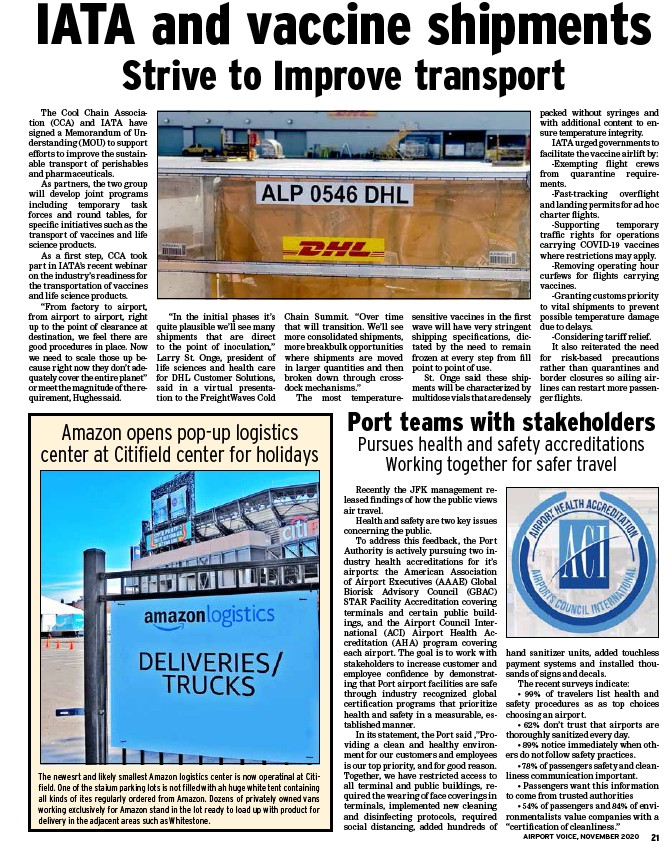
IATA and vaccine shipments
Strive to Improve transport
AIRPORT VOICE, NOVEMBER 2020 21
The Cool Chain Association
(CCA) and IATA have
signed a Memorandum of Understanding
(MOU) to support
efforts to improve the sustainable
transport of perishables
and pharmaceuticals.
As partners, the two group
will develop joint programs
including temporary task
forces and round tables, for
specific initiatives such as the
transport of vaccines and life
science products.
As a first step, CCA took
part in IATA’s recent webinar
on the industry’s readiness for
the transportation of vaccines
and life science products.
“From factory to airport,
from airport to airport, right
up to the point of clearance at
destination, we feel there are
good procedures in place. Now
we need to scale those up because
right now they don’t adequately
cover the entire planet”
or meet the magnitude of the requirement,
Hughes said.
“In the initial phases it’s
quite plausible we’ll see many
shipments that are direct
to the point of inoculation,”
Larry St. Onge, president of
life sciences and health care
for DHL Customer Solutions,
said in a virtual presentation
to the FreightWaves Cold
Chain Summit. “Over time
that will transition. We’ll see
more consolidated shipments,
more breakbulk opportunities
where shipments are moved
in larger quantities and then
broken down through crossdock
mechanisms.”
The most temperaturesensitive
The newesrt and likely smallest Amazon logistics center is now operatinal at Citifield.
One of the staium parking lots is not filled with ah huge white tent containing
all kinds of ites regularly ordered from Amazon. Dozens of privately owned vans
working exclusively for Amazon stand in the lot ready to load up with product for
delivery in the adjacent areas such as Whitestone.
vaccines in the first
wave will have very stringent
shipping specifications, dictated
by the need to remain
frozen at every step from fill
point to point of use.
St. Onge said these shipments
will be characterized by
multidose vials that are densely
packed without syringes and
with additional content to ensure
temperature integrity.
IATA urged governments to
facilitate the vaccine airlift by:
-Exempting flight crews
from quarantine requirements.
-Fast-tracking overflight
and landing permits for ad hoc
charter flights.
-Supporting temporary
traffic rights for operations
carrying COVID-19 vaccines
where restrictions may apply.
-Removing operating hour
curfews for flights carrying
vaccines.
-Granting customs priority
to vital shipments to prevent
possible temperature damage
due to delays.
-Considering tariff relief.
It also reiterated the need
for risk-based precautions
rather than quarantines and
border closures so ailing airlines
can restart more passenger
flights.
Amazon opens pop-up logistics
center at Citifield center for holidays
Port teams with stakeholders
Pursues health and safety accreditations
Working together for safer travel
Recently the JFK management released
findings of how the public views
air travel.
Health and safety are two key issues
concerning the public.
To address this feedback, the Port
Authority is actively pursuing two industry
health accreditations for it’s
airports: the American Association
of Airport Executives (AAAE) Global
Biorisk Advisory Council (GBAC)
STAR Facility Accreditation covering
terminals and certain public buildings,
and the Airport Council International
(ACI) Airport Health Accreditation
(AHA) program covering
each airport. The goal is to work with
stakeholders to increase customer and
employee confidence by demonstrating
that Port airport facilities are safe
through industry recognized global
certification programs that prioritize
health and safety in a measurable, established
manner.
In its statement, the Port said ,”Providing
a clean and healthy environment
for our customers and employees
is our top priority, and for good reason.
Together, we have restricted access to
all terminal and public buildings, required
the wearing of face coverings in
terminals, implemented new cleaning
and disinfecting protocols, required
social distancing, added hundreds of
hand sanitizer units, added touchless
payment systems and installed thousands
of signs and decals.
The recent surveys indicate:
• 99% of travelers list health and
safety procedures as as top choices
choosing an airport.
• 62% don’t trust that airports are
thoroughly sanitized every day.
• 89% notice immediately when others
do not follow safety practices.
• 78% of passengers safety and cleanliness
communication important.
• Passengers want this information
to come from trusted authorities
• 54% of passengers and 84% of environmentalists
value companies with a
“certification of cleanliness.”